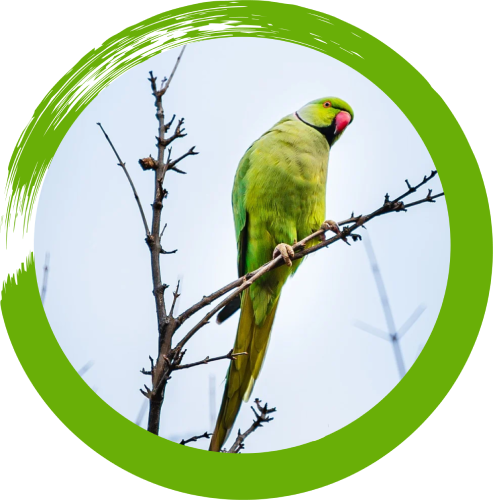- Home
- Birds Species
About Birds Species
The International Union for Conservation of Nature (IUCN) estimates that there are 10,721 distinct birds species throughout the globe. But as new species are found and some are reclassified or become extinct, this figure is always changing.
Birds range in size from small hummingbirds to large ostriches.
Water birds(1,300 species)
The assorted assortment of bird species that primarily inhabit freshwater or marine habitats are called water birds. Aquatic or waterfowl birds; commonly known as. They consist of several water birds, such as (ducks, swans, geese, and herons) they are particularity adapted for swimming.
Numerous waterfowl are equipped with distinctive features, such as webbed feet for swimming, and long beaks designed to catch other aquatic prey.

Shorebirds(200 species)

Waders, another name for shorebirds, are a varied group of bird species that are usually found in wetlands, estuaries, mudflats, and coastal shorelines. These birds are distinguished by their long legs, slim bodies, and sharp beaks, which are designed for feeding in soft mud or shallow water. Among the common shorebird species are curlews, sandpipers, plovers, and oystercatchers. They use their beaks to probe the sand or mud in search of food, and they eat a wide range of species, including insects, crabs, worms, and tiny fish.
Landbirds(6,500 species)
Land birds, sometimes referred to as terrestrial birds, are a diverse group of bird species that mostly inhabit terrestrial environments such as grasslands, woodlands, deserts, and urban areas. Land birds are adapted to survive on land and are not commonly seen in aquatic environments, in contrast to shorebirds and waterbirds. Numerous species are included in this group, including woodpeckers, pigeons, songbirds, and sparrows.

Birds of Prey(550 species)

Raptors, another name for this group of carnivorous birds, are known as birds of prey because they hunt and eat other animals. They are distinguished by their huge beaks, strong talons, and acute vision, all of which are designed to help them grab and devour prey. Many species, including eagles, hawks, falcons, owls, kites, and vultures, are included in this group. Predator birds can be found in a wide range of environments worldwide, including mountains, grasslands, deserts, and woods.
Parrots(350 species)
Psittaciformes parrots are a varied group of brightly colored, highly intelligent birds that are mostly found in tropical and subtropical regions of the world. With their vivid feathers, powerful, curved beaks, and zygodactyl feet—which have two toes pointing forward and two backward—parrots are recognized for their exceptional grasping and handling abilities. Numerous species, including parakeets, lorikeets, macaws, cockatoos, and lovebirds, are included in this category.

Pigeons and Doves(300 species)

Species of the Columbidae family of birds, which includes pigeons and doves, are widely distributed around the world and can be found in a range of environments, including grasslands, woods, cities, and deserts. In addition to having small heads, short necks, and robust bodies, they are renowned for having calm, peaceful temperaments. Even though "dove" and "pigeon" are sometimes used synonymously, "dove" usually refers to smaller species and "pigeon" to bigger ones.
Nightjars and Frogmouths(130 species)
Belonging to the order Caprimulgiformes, nightjars, and frogmouths are nocturnal birds distinguished by their enigmatic plumage and distinctive behaviors. Designed for a life of airborne hunting, nightjars are slender birds with short legs and long wings. Their natural habitats are open spaces like woods, savannas, and grasslands. Nightjars snooze on the ground or perch on branches during the day, blending in perfectly with their surroundings because of their outstanding camouflage. They are very active at night, using their broad mouths and specially designed bristles around their beaks to catch insects as they flit.

Swifts and Hummingbirds(120 species)

Two separate families of small, aerial birds in the order Apodiformes are recognized for their remarkable flying abilities: the swifts and the hummingbirds.
Swifts are renowned for having extraordinary airborne speed and agility. These birds may spend the majority of their lives in flight thanks to their large, narrow wings and aerodynamic bodies. Swifts may be found all throughout the world and are especially good at catching insects midair with amazing accuracy. They migrate widely, covering great distances to find breeding and wintering areas. Swifts are frequently observed darting across the sky at great speeds and are well-known for their aerial acrobatics.
